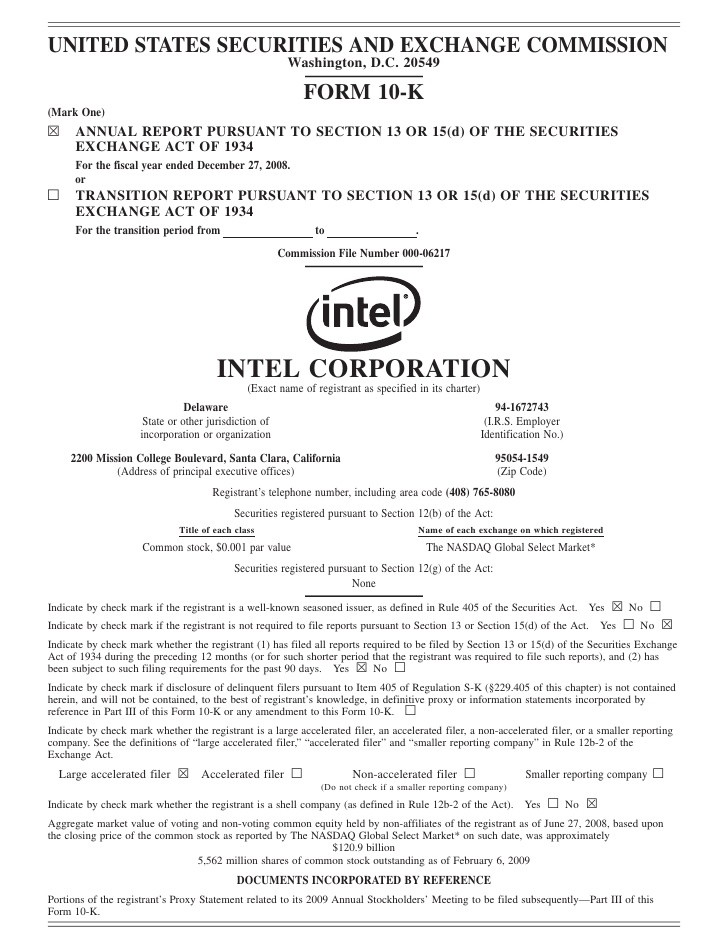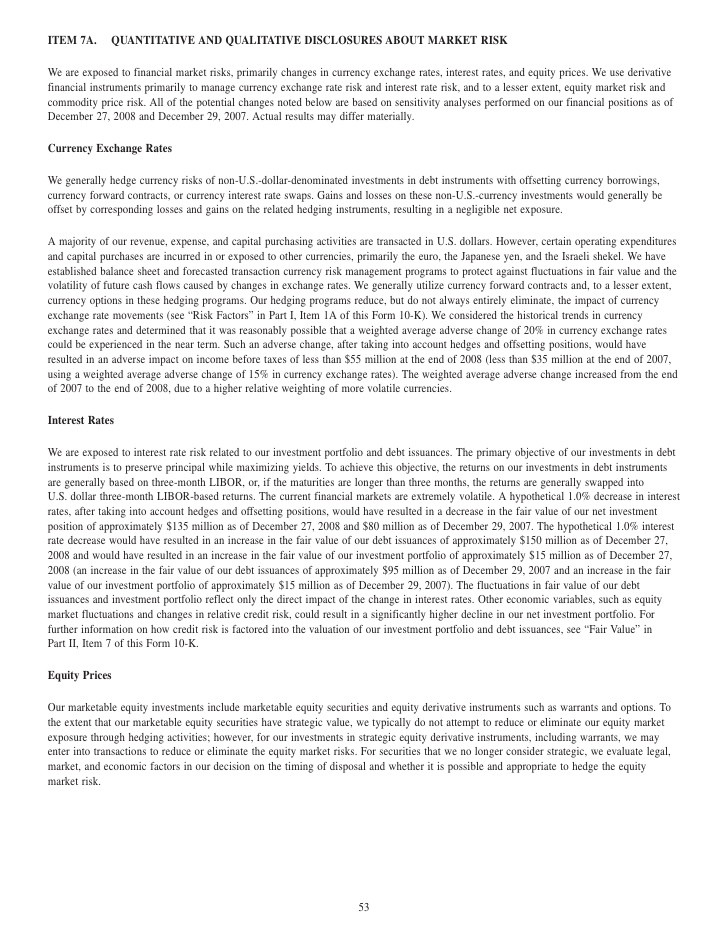Intel 2011 Annual Report Critical Accounting Estimates LongLived Assets
Post on: 20 Май, 2015 No Comment

Property, Plant and Equipment
We assess property, plant and equipment for impairment when events or changes in circumstances indicate that the carrying value of the assets or the asset grouping may not be recoverable. Factors that we consider in deciding when to perform an impairment review include significant under-performance of a business or product line in relation to expectations, significant negative industry or economic trends, and significant changes or planned changes in our use of the assets. We measure the recoverability of assets that will continue to be used in our operations by comparing the carrying value of the asset grouping to our estimate of the related total future undiscounted net cash flows. If an asset grouping’s carrying value is not recoverable through the related undiscounted cash flows, the asset grouping is considered to be impaired. The impairment is measured by comparing the difference between the asset grouping’s carrying value and its fair value. Property, plant and equipment is considered a non-financial asset and is recorded at fair value only if an impairment charge is recognized.
Impairments are determined for groups of assets related to the lowest level of identifiable independent cash flows. Due to our asset usage model and the interchangeable nature of our semiconductor manufacturing capacity, we must make subjective judgments in determining the independent cash flows that can be related to specific asset groupings. In addition, as we make manufacturing process conversions and other factory planning decisions, we must make subjective judgments regarding the remaining useful lives of assets, primarily process-specific semiconductor manufacturing tools and building improvements. When we determine that the useful lives of assets are shorter than we had originally estimated, we accelerate the rate of depreciation over the assets’ new, shorter useful lives. Over the past 12 quarters, including the fourth quarter of 2011, impairments and accelerated depreciation of property, plant and equipment ranged from $10 million to $75 million per quarter.
Goodwill
Goodwill is recorded when the purchase price paid for an acquisition exceeds the estimated fair value of the net identified tangible and intangible assets acquired. Goodwill is allocated to our reporting units based on relative fair value of the future benefit of the purchased operations to our existing business units as well as the acquired business unit. Reporting units may be operating segments as a whole or an operation one level below an operating segment, referred to as a component. Our reporting units are consistent with the operating segments identified in Note 30: Operating Segment and Geographic Information in Part II, Item 8 of this Form 10-K.
We perform an annual impairment assessment in the fourth quarter of each year, or more frequently if indicators of potential impairment exist, to determine whether it is more likely than not that the fair value of a reporting unit in which goodwill resides is less than its carrying value. For reporting units in which this assessment concludes that it is more likely than not that the fair value is more than its carrying value, goodwill is not considered impaired and we are not required to perform the two-step goodwill impairment test. Qualitative factors considered in this assessment include industry and market considerations, overall financial performance, and other relevant events and factors affecting the reporting unit.
For reporting units in which the impairment assessment concludes that it is more likely than not that the fair value is less than its carrying value, we perform the first step of the goodwill impairment test, which compares the fair value of the reporting unit to its carrying value. If the fair value of the reporting unit exceeds the carrying value of the net assets assigned to that unit, goodwill is not considered impaired and we are not required to perform further testing. If the carrying value of the net assets assigned to the reporting unit exceeds the fair value of the reporting unit, then we must perform the second step of the goodwill impairment test in order to determine the implied fair value of the reporting unit’s goodwill. If, during this second step, we determine that the carrying value of a reporting unit’s goodwill exceeds its implied fair value, we would record an impairment loss equal to the difference.
Determining the fair value of a reporting unit involves the use of significant estimates and assumptions. Our goodwill impairment test uses a weighting of both the income and market methods to estimate the reporting unit’s fair value. The income method is based on a discounted future cash flow approach that uses the following reporting unit estimates: revenue, based on assumed market segment growth rates and Intel’s assumed market segment share; estimated costs; and appropriate discount rates based on the reporting units’ weighted average cost of capital as determined by considering the observable weighted average cost of capital of comparable companies. Our estimates of market segment growth, our market segment share, and costs are based on historical data, various internal estimates, and a variety of external sources, and are developed as part of our routine long-range planning process. The same estimates are also used in planning for our long-term manufacturing and assembly and test capacity needs as part of our capital budgeting process, and for both long-term and short-term business planning and forecasting. We test the reasonableness of the inputs and outcomes of our discounted cash flow analysis against available comparable market data. The market method is based on financial multiples of comparable companies and applies a control premium. The reporting unit’s carrying value represents the assignment of various assets and liabilities, excluding certain corporate assets and liabilities, such as cash, investments, and debt.
During the fourth quarter of each of the prior three fiscal years, we completed our annual impairment assessments, and impairment tests when necessary, and concluded that goodwill was not impaired in any of these years.

Identified Intangibles
We make judgments about the recoverability of purchased finite-lived intangible assets whenever events or changes in circumstances indicate that an impairment may exist. Recoverability of finite-lived intangible assets is measured by comparing the carrying amount of the asset to the future undiscounted cash flows that the asset is expected to generate. We review indefinite-lived intangible assets for impairment quarterly and whenever events or changes in circumstances indicate that the carrying value may not be recoverable. Recoverability of indefinite-lived intangible assets is measured by comparing the carrying amount of the asset to the future discounted cash flows that the asset is expected to generate. If it is determined that an individual asset is impaired, the amount of any impairment is measured as the difference between the carrying value and the fair value of the impaired asset.
The assumptions and estimates used to determine future values and remaining useful lives of our intangible and other long-lived assets are complex and subjective. They can be affected by various factors, including external factors such as industry and economic trends, and internal factors such as changes in our business strategy and our forecasts for specific product lines. Based on our impairment reviews of our intangible assets, we recognized impairment charges of approximately $10 million in 2011 and no impairment charges in the prior two fiscal years.
- Previous Page
Non-Marketable Equity Investments Next Page














